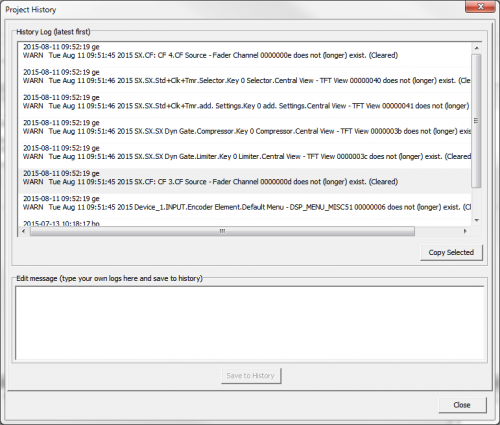Table of Contents
Program Menus
In this section of the manual, the menus and the commands of the SXConfig software are described.
Project / File Menu
New Device
A new device is created. The device contains only the default values.
This command can also be executed by clicking ![]() in the toolbar.
in the toolbar.
If a device file is already open, it can be saved before creating the new file.
Note
In SXConfig, only one device file can be shown at the same time. It is possible to open the SXConfig software several times on a PC to be able to edit several devices at the same time.
Open
An already existing device file is opened.
You can execute this command also by clicking ![]() in the toolbar or by pressing
in the toolbar or by pressing Ctrl+O.
If a device file is open already, it can be saved before opening the new file.
Save
The current device is saved.
The command can also be executed by clicking ![]() in the toolbar or by pressing
in the toolbar or by pressing Ctrl+S on the keyboard.
Save As
The current device file is saved with a different name. The program suggests the current name in the Save dialog box. The new device file is available for further configuration directly after saving, the original file is closed.
You are automatically working with the new created file after saving.
History | v7
Using the History function in the File menu of SXConfig, you can log modifications of the configuration. This way, you can later reproduce, which user made which modifications of the system at which time.
In the File menu click History; the Project History window opens. On the Project Message History tab, in the History Log area, the single entries are shown with date and time, as well as the login name of the user (Microsoft Windows Login) who created the entry. SXConfig itself logs some processes, for example when and by who a configuration was originally created. Other changes that seem important to you can be inserted manually.
To do this, select the New Message tab, type the new message and click Save to log the text in the history. Click Clear to delete the whole text that is entered in the Enter Message box.
To show a message, on the Project Message History tab, select an entry in the History Log list. The text is then shown in the Message box.
Note
A history entry can not be changed or deleted, once the entry was saved.
Export AudioIDs/LogicsIDs | v8
This command saves the audio and logic IDs of a device as file with the extension .dpx. Any name can be chosen for the file.
The content of this file is useful if you want third party devices to communicate with the DHD system by an external protocol. Because the audio and logic IDs are assigned dynamically in TB8, it is necessary to take a look at this list. Therefore, open the file with a text editor.
Last Used Files
Shows you the last four files used with your user account.
Using this command, different printouts can be arranged.
You can also execute this command by clicking in the toolbar.
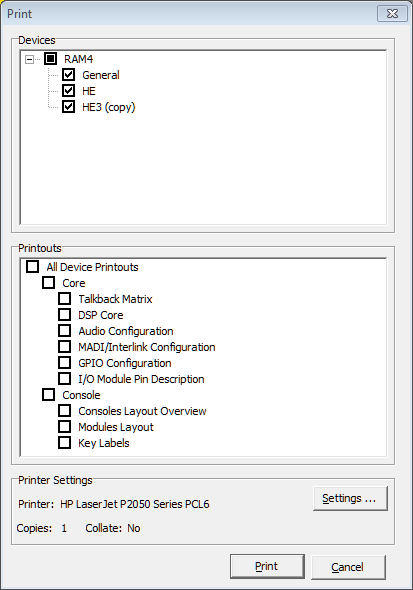
In the Print dialog, you can choose in the Devices area, which device in the project the printout is intended for. Select the project root (indicated by the project name) to include all devices or select just single devices.
In the Printouts area you can select, which parts of the documentation of the selected devices are to be printed.
The option All Printouts includes the complete documentation of the selected devices. Alternatively, you can also print all printouts of the DSP frames and/or all printouts of the console view as well as single parts of the documentation. You can select the following print sections:
 - Section-Namen an screenshot anpassen
- Section-Namen an screenshot anpassen
Frame View: View of the DSP frame with selected board configuration.Audio Configuration: List of audio configurations with corresponding labels, slot- and port numbers and further options. To keep the list compact, no MADI modules are included.MADI Configuration: List of MADI configurations with corresponding labels, slot- and port numbers and further options. To keep the list compact, only MADI modules are included.GPIO Configuration: List of GPIO configurations with corresponding labels, slot- and port numbers.I/O Cards Pin Description: Pin assignment of all ports of the configured audio boards (analog and digital) are printed.Console Layout Overview: View of the complete mixer interface on one or more pages, depending on the number of used racks.Modules Layout: View of all operating modules contained in the configuration, each shown on one page.Key Labels: Printout of all key labels available in the configuration on one or more pages. For printing, presentation transparencies and an appropriate printer should be used. The printed labels can be cut out and inserted in the key caps.
Exit
This command quits the SXConfig software. A message prompting you to save an open device file is shown if its current state is not saved yet.
View Menu
Maintenance Window
Using this command, you open the maintenance window. In this window, you have direct access to the modules of DHD systems, important settings and services. These functions are of a great variety and are therefore dealt with in an own chapter. (See Maintenance Documentation)
Note
The functions that can be triggered from the maintenance window do not affect an open device file. If you want to access maintenance functions in SXConfig only, it is not necessary to load a device file.
You can also open or enable the maintenance window by pressing F7.
Key Functions
This window shows all Key Functions that are available for configuring the keys or TFT buttons of the device. A key must be selected on the Console tab. The key functions are divided into groups according to their characteristics.
You can open or enable the window also by pressing F8.
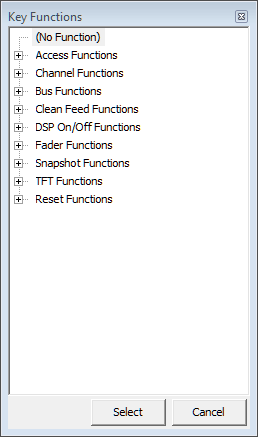
Logic Sources
This window shows all internal logic signals that are available for configuring the device. The logic sources are grouped according to their characteristics.
You can also open this window by pressing F5.
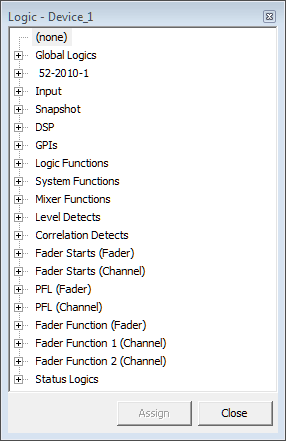
Potentiometer / Encoder Sources | v8
This window shows all Potentiometer / Encoder Sources that are available for assigning a potentiometer/fader to the selected potentiometer function.
You can open this window by pressingg F9
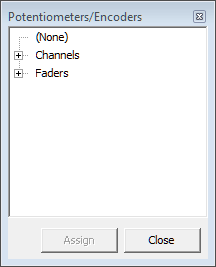
Audio Sources
This window shows all internal audio signals that are available for configuring the selected device. The audio signals are grouped according to their characteristics.
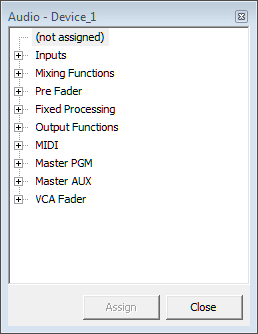
On the internal TDM bus, the following audio channels are available: inputs, delays, mixing functions (sums, groups, Aux busses) pre-fader signals (fader channel after input processing), clean feeds (n-1 busses), monitor functions, fixed processing, output functions, super output functions and talk outputs.
You can also open this window by pressing F6.
Watches - Logic Monitor
With the Logic View window you can monitor all logics of the currently loaded TB8 project.
For clearness, you can create several views including logics. Click ![]() to generate a new view,
to generate a new view, ![]() deletes a view and with
deletes a view and with ![]() you can rename it. All views are available in the
you can rename it. All views are available in the Logic Monitor Set list.
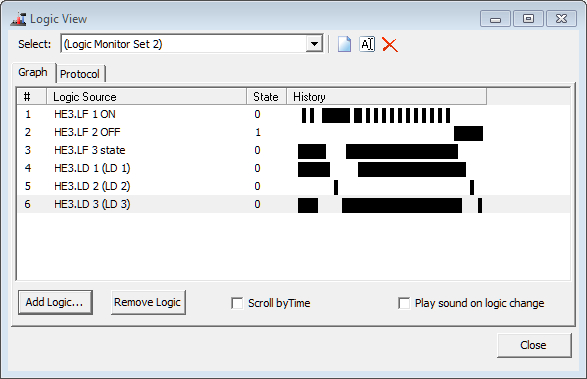
The Graph tab shows all logics in a time line. Click Add Logic to open the Logic Sources window and to add a new logic to the view. Remove Logic deletes the selected logic from the list. On the left hand side of the window you can find the labels of all inserted logics. The graphical view next to these labels shows the state of the logics at different times. The intervals of the on/off periods are not related to the time, but to each other. For example you can see that DAW 1\1 was activated first, afterwards DAW 1\2 was activated and so on. All labels with a grey background are currently active.
If you select the Scroll by Time check box, the history is not shown and you will only see, which logics are currently active. Moreover, it is possible to clear the history and to activate a sound that signalises the change of logic states.
Instead of the graphical view, you can choose the Protocol tab. Here, you can find the changes of the logic states and the absolute time the changes did occur.
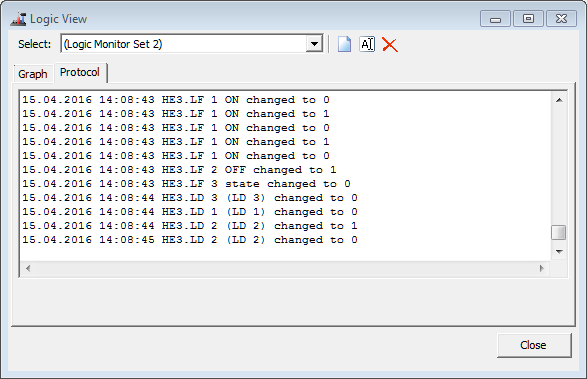
Transfer Menu
Connecting Computer and Device
To load a Config from a device to the Toolbox5 software or write it back to the device after modifying it, the configuration data has to be exchanged between the configuration PC and the devices. This is done by an Ethernet connection using TCP/IP.
The commands Load to Device and Load from Device load and store a Config to and from the device respectively. In the Toolbox5 software, you can choose between different options, how the configuration PC can exchange data with the device.
In any case, you have to select the desired device from the project tree first and then select the command for up- or download. After that, the DHD Connection Dialog window opens that is identical for both commands.
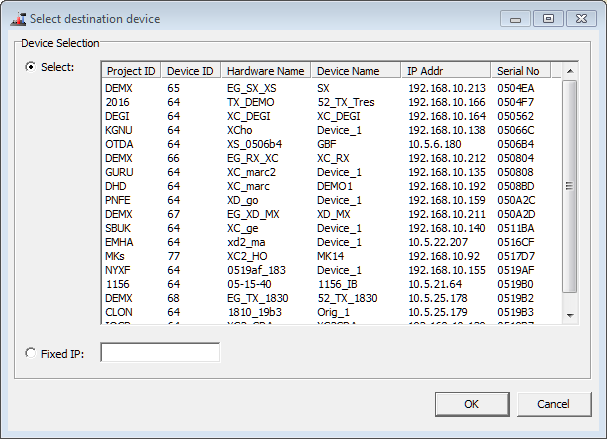
The devices use the UDP protocol to announce their availability in the network. This requires that UDP packets can be transferred between the DSP frames and the configuration PC. This is not always possible in all networks.
Note
If no UDP packets are transferred between the TB8 software and the devices, the list of all available DHD systems is not shown in the DHD Connection Dialog. In this case, you have to know exactly, which IP addresses belong to which device, and enter them manually in the Fixed IP box.
If the configuration PC and the devices can communicate via the UDP protocol, the list in the DHD Connection Dialog window shows all available systems. You can now select the desired destination from the list.
After transferring a configuration to a device, in the status bar of the TB8 window the message Project modified is shown. During the transfer, a time stamp is set in the file that is also transferred to the device. According to this time stamp, the TB8 software can recognize, whether the configuration in the device differs from the one in the file. The data stamp of the file or the time of the last transfer are shown under <Device>/Options in the Last changed box. If the configuration has never been transferred to a device, no timestamp is shown.
In the project tree, apart from the device name, the term Online is shown if the project ID and the device ID of the project file are identical with the data in the device. If the software configuration has been changed compared with the one in the device, the additional message Modified is shown.
There are the following options for setting up a connection:
Select: In the list, all devices connected to the IP network segment are listed. This list is created automatically via UDP broadcast messages that are received from the devices. For each device, the appropriate project ID, device ID and the hardware and device name are shown, as well as the IP address. TheSerial Nocolumn shows the serial number of the device which is identical with the company-specific bytes of the Ethernet MAC address of the device. Select the desired device by mouse clicking.Fixed IP: Here, you can enter the IP address of the device directly. This may be necessary if no UDP packets can be received, if the configuration PC and the device are located in different network segments. For remote servicing of systems this option might be helpful as well.
If you want to connect the device directly to the configuration PC with an ethernet cable:
- Assign static IP addresses on both sides (no DHCP). The first 3 bytes of the address must be identical, the last byte must differ, like the following example:
| IP address on Toolbox5-PC | 192.168.010.057 |
| IP address of device | 192.168.010.058 |
| Subnet mask | 255.255.255.0 |
Note
You do not need a twisted ethernet cable (x-cable / cross cable) for direct connections.
Note on the Configuration of IP addresses
Each device needs an unambiguous IP address that is either set statically or assigned by a DHCP server. The appropriate setting can be found under Network Configuration in the Maintenance Window.
If the devices are not constantly connected to an IP network, you should use static IP addresses. Do not assign any of the IP addresses twice. Don't operate devices with DHCP enabled if no DHCP server is available on the network.
Load to Device
This command copies the current configuration from the TB8 software to the selected device. To do this, first select the device in the project tree, the configuration of which you want to copy and then use the command Load to Device. The DHD Connection Dialog window opens, in which you can select the desired device. After confirming the selection, the new configuration is transferred. If the name of the device in the project and the one of the device selected in the network should not be identical, the following message is shown:
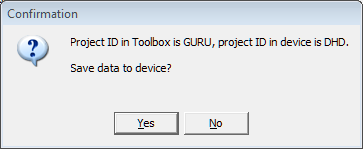
Warning
Loading a new configuration overwrites a configuration already existing in the device. Therefore, if in doubt, save the current configuration before making any changes using the Load from Device command and save it to a file.
The command Load to Device can also be executed by clicking in the toolbar.
Load from Device
This command loads a configuration from a device to the TB8 software. If you use a project file with several devices, make sure to select the correct device before selecting the command. In the DHD Connection Dialog window you must select the corresponding device.
Note
If the device you are downloading a configuration from is already included in the project, it is automatically selected in the DHD Connection Dialog. This requires identical values for project ID and device ID both in the project and the device itself.
Alternatively, you can create an empty project and insert an empty device by clicking Add or using the contextual menu. Then, load the configuration into this empty device.
Further on, you can select a device in a loaded project file and overwrite its configuration with data from a device using the command Load from Device.
Warning
Be aware that changes of the project caused by downloads can not be undone, as soon as the project file is saved. Therefore, for safety reasons, always work with copies of the original project files.
Loading a configuration from a device is not useful to rebuild a complete project, because the global project settings (global logics and global potentiometers, settings of the talkback system, authorization groups and user accounts, linked devices and so on) are not loaded from the device. That is why you should always work with the last status of the project file because the central resources named above have to be identical for all devices in the project. If you load the data for global functions from other devices, these might overwrite the settings of the current project file!
In general, it is always better to save the current configuration of a project as project file. If then other changes become necessary, load the project file again and modify it. After that, load the new configuration to the corresponding devices. This way, the project file is always up to date and is available as a backup for the configuration data in the devices at the same time.
Tip
DHD does not recommend loading configuration from device.
Options Menu
With the settings in the Options menu, only options are set that affect the operation of the TB8 software. They have no effect on the configuration of the devices.
Configuration
After selecting Configuration, the Toolbox Configuration window opens. The options are explained in detail in the following table.
Files-Tab
| area | option | description |
|---|---|---|
| Project Files Save | Backup Levels | • Define here, how many backup generations shall be created. (min.=0, max.=100) |
| Auto Save each | • If this check box is selected, the software creates backups of the project file automatically. • The number of backup files can be set in the Backup Levels box. If the last file is written, the first is overwritten when saving the next time. This way, it is lost!• The desired interval between two backups can be entered in the Auto Save each (min.=0 minutes, max.=100 minutes) box.• The created backup files have the number of the backup in their extensions, for example .dd1. The higher this number is, the newer is this file. If you want to use such a file in the TB8 software again, previously you have to change its extension to .ddp again. |
|
| Path for backup files | Decide, where TB8 stores project backups | |
| File Menu | Show recently used files list | • If this check box is selected, only the defined number of recently opened projects is offered as a quick start option in the File menu. • The desired number of entries can be defined in the Show recently used files list box. (min.=0 entries, max.=20 entries) |
View-Tab
| area | option | description |
|---|---|---|
| Navigator | View follows selected object automatically | • By selecting this check box, the content of the navigator automatically adapts to the options and functions that are currently edited. |
| Reset Views | Delete all custom view settings. Use this function when expiriencing graphical malfunctions with TB8 Software. Restart of TB8 software required |
Audio and Logic Sources-Tab
| area | option | description |
|---|---|---|
| Audio and Logic Tree | Hide sources without label | • This option influences the Audio sources window. If it is enabled, audio sources with deleted labels in the I/O Overview, are deactivated. (See also I/O Overview) |
| Assignment | Automatically select next item | • Select this check box to work quicker when defining the output routing: In this case, the Toolbox5 software selects the following output automatically when assigning audio signals to the outputs - in the output list as well as in the list of audio signals in the Audio Sources window. (See also I/O Overview) |
Product Filter-Tab
If you can not find the product you need in the TB8 Software, you may need to set your Product filters. This happens if a product is classfied in one of the three categories:
 preferred product: regular production, mostly sufficient stock
preferred product: regular production, mostly sufficient stock
 product with potential delivery times: production start requires prior order, delivery times depend on module type and vary from a few days to several weeks
product with potential delivery times: production start requires prior order, delivery times depend on module type and vary from a few days to several weeks
 ask for quotation: production and prices on enquiry, a minimum order quantity might apply depending on module type, production start requires prior order, delivery times depend on module type and vary from a few days to several weeks, no return possible, documentation might be incomplete or unavailable, module might be not available in the Toolbox configuration software, a prior current quotation is always required
ask for quotation: production and prices on enquiry, a minimum order quantity might apply depending on module type, production start requires prior order, delivery times depend on module type and vary from a few days to several weeks, no return possible, documentation might be incomplete or unavailable, module might be not available in the Toolbox configuration software, a prior current quotation is always required
 product discontinued: no restaging possible, please find reference for potential alternatives with your DHD dealer or DHD directly
product discontinued: no restaging possible, please find reference for potential alternatives with your DHD dealer or DHD directly
Help Menu
About
If you select About, the Information window opens.
Here, the date of creation of the software and the version of the used TB8 are shown, for example Version 8.1.4 Please always mention the complete version name when asking for servicing.
The version number of the DHDCS that is included in TB8 is also shown in this window.
